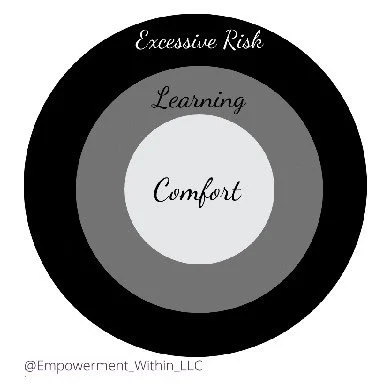Pushing Outside the Comfort Zone and Into Growth
By: Patrice Flanagan-Morris, LCSW
Pema Chodron discusses the three zones above in her book Welcoming the Unwelcome. Pema outlines how to move through comfort into learning and be aware/cautious of excessive risk. This process is individualized and changes throughout our lives. Take steps to see where you are now and where you can grow!
Comfort:
The comfort zone is where we find calm and ease. We can take a break and breath, and the comfort zone can be our reprieve. Comfort zones become unhealthy when we stay too long. We don’t trust ourselves to venture out, we put up walls, and we just want to feel safe. When we stay too long, our comfort zone shrinks. More on the outside feels scary and unknown, we start to search only for certainty. The more often we move into the learning zone the more our comfort zone increases, we can find more comfort in uncertainty.
Learning:
Learning pushes us outside of our comfort and can look like learning new ideologies, having new experiences, and engaging with different people. Learning does not mean the absence of fear, instead, we embrace the challenging and fearful and work towards overcoming. This brings fulfillment, engagement, and overall satisfaction to our lives. We start to see who we truly are and all that we can accomplish.
Unnecessary Risk:
Unnecessary risk is when we push ourselves too far, too fast, or into something that is not going to benefit us. In unnecessary risk, our other zones tend to shrink as we start to see ourselves as incapable and want to venture into learning less often.
Distinguishing between unnecessary risk and learning can be challenging at times. The first step is understanding what level of fear your nervous system can manage without moving toward overwhelm. Another step is having a support system around you for times of challenge and having a set of coping skills to support you.
As you start to go into your learning zone and gain trust that you will know where the line of unnecessary risk is, your comfort and learning zones grow. In turn, you are able to push yourself a little farther, find and take more opportunities you didn’t know existed, and create more space to find and be who you are.
Draw out the above diagram and write what being in your comfort/learning/unnecessary risk zones looks like. What does it feel like in your body, what are your thoughts and emotions in each? What experiences and people go into your comfort zone? Are there small ways, new opportunities, and ideas in the back of your head that could push you into learning and not into risk?

